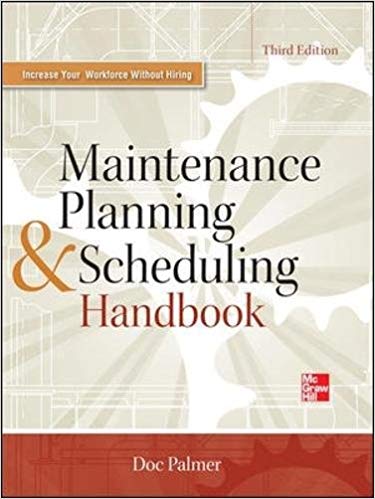Publisher's Note: Products purchased from Third Party sellers are not guaranteed by the publisher for quality, authenticity, or access to any online entitlements included with the product.
The fully updated industry-standard guide tomaintenance planning and scheduling
Written by a Certified Maintenance and Reliability Professional (CMRP) with more than three decades ofexperience, this thoroughly revised resource provides proven planning and scheduling strategies that willtake any maintenance organization to the next level of performance. The book covers the accuracy oftime estimates, the level of detail in job plans, creating schedules, staging material, utilizing a CMMS, andmore, all designed for increasing your workforce without hiring.
Maintenance Planning and Scheduling Handbook, Third Edition features major additions to the businesscase for planning and scheduling, new case studies, an expanded chapter on KPIs with sample calculations, a new chapter on successful outage management, and a new appendix illustrating how to easily conduct an in-house productivity study. New discussions reveal how the principles of planning and scheduling closely follow the timeless management principles of Dr. W. Edwards Deming and Dr. Peter F. Drucker. This comprehensive guide delivers the experience, advice, and know-how necessary toestablish a world-class maintenance operation.
Detailed coverage of:
- The business case for the benefit of planning
- Planning principles
- Scheduling principles
- Dealing with reactive maintenance
- Basic planning
- Advance scheduling
- Daily scheduling and supervision
- Forms and resources
- The computer in maintenance
- How planning interacts with preventive maintenance, predictive maintenance, and project work
- How to control planning and use associated KPIs for planning and overall maintenance
- Shutdown, turnaround, overhaul, and outage management
- Conclusion: start planning
چکیده فارسی
توجه ناشر: محصولات خریداری شده از فروشندگان شخص ثالث توسط ناشر برای کیفیت، اصالت یا دسترسی تضمین نمی شوند. به هر گونه حقوق آنلاین موجود در محصول.
راهنمای استاندارد صنعتی کاملاً به روز شده برنامه ریزی و برنامه ریزی نگهداری
نوشته شده توسط یک متخصص تعمیر و نگهداری و قابلیت اطمینان (CMRP) با بیش از سه دهه تجربه، این منبع کاملاً تجدید نظر شده استراتژی های برنامه ریزی و زمان بندی اثبات شده ای را ارائه می دهد که هر سازمان تعمیر و نگهداری را به سطح بعدی عملکرد می برد. این کتاب دقت تخمینهای زمان، سطح جزئیات در برنامههای شغلی، ایجاد برنامهها، مرحلهبندی مواد، استفاده از CMMS و موارد دیگر را پوشش میدهد که همه برای افزایش نیروی کار شما بدون استخدام طراحی شدهاند.
راهنمای برنامهریزی و برنامهریزی تعمیر و نگهداری، ویرایش سوم دارای اضافات عمده برای برنامهریزی و زمانبندی، مطالعات موردی جدید، فصل گستردهای در KPI با محاسبات نمونه، فصل جدیدی در مدیریت موفق قطعی، و یک پیوست جدید نشان می دهد که چگونه می توان به راحتی یک مطالعه بهره وری داخلی را انجام داد. بحثهای جدید نشان میدهد که چگونه اصول برنامهریزی و زمانبندی دقیقاً از اصول مدیریت بیزمان دکتر دبلیو. ادواردز دمینگ و دکتر پیتر اف. دراکر پیروی میکنند. این راهنمای جامع تجربه، مشاوره و دانش لازم برای ایجاد یک عملیات تعمیر و نگهداری در سطح جهانی را ارائه می دهد.
پوشش تفصیلی از:
- مورد کسب و کار به نفع برنامه ریزی
- اصول برنامه ریزی
- اصول برنامه ریزی
- برخورد با تعمیر و نگهداری واکنشی
- برنامه ریزی اساسی
- زمانبندی قبلی
- برنامه ریزی و نظارت روزانه
- فرم ها و منابع
- کامپیوتر در حال تعمیر
- نحوه تعامل برنامهریزی با تعمیر و نگهداری پیشگیرانه، نگهداری پیشبینیکننده و کار پروژه
- نحوه کنترل برنامه ریزی و استفاده از KPIهای مرتبط برای برنامه ریزی و نگهداری کلی
- خاموش کردن، چرخش، تعمیرات اساسی، و مدیریت خاموشی
- نتیجه گیری: شروع به برنامه ریزی کنید
ادامه ...
بستن ...
Ebook details:
عنوان: Maintenance Planning and Scheduling Handbook 3/E
نویسنده: Richard (Doc) D. Palmer
ناشر: McGraw-Hill Education; 3 edition (September 4, 2012)
زبان: English
شابک: 007178411X, 978-0071784115
حجم: 95 Mb
فرمت: Epub + Converted Pdf
ادامه ...
بستن ...
Contents
Foreword
Preface
Preface to First Edition
Acknowledgments
Prologue: A Day in the Life—May 10, 2020
Bill, Mechanic at Delta Ray, Inc., No Planning
Sue, Supervisor at Zebra, Inc., No Planning
Juan, Welder at Alpha X, Inc., Has Planning
Jack, Planner at Johnson Industries, Inc.
Charles, Predictive Maintenance Technician at Beta X, Inc., No Scheduling
1 The Business Case for the Benefit of Planning (Why Do Planning?)
Company Vision
Why Improvement Is Needed in Maintenance
What Planning Mainly Is and What It Is Mainly Not (e.g., Parts and Tools)
Increase Your Workforce Without Hiring
Case Study: The Practical Result of Planning Is Freed-Up Technicians
“World Class” Wrench Time
The Specific Benefit of Planning Calculated for Labor Only
The Specific Benefit of Planning Calculated beyond Labor: The Ultimate Benefit
Plant Staffing Level
Why Does This Opportunity Exist?
Quality and Productivity: Effectiveness and Efficiency
Planning Mission
Frustration with Planning
W. Edwards Deming
Peter F. Drucker
Summary
Overview of the Chapters and Appendices
2 Planning Principles (What Makes Planning So Frustrating and What Makes It Work?)
The Planning Vision: The Mission
Principle 1: Separate Group
Illustrations
Principle 2: Focus on Future Work
Institutionalizing Plant Knowledge
Emergencies
Case Study: Insist on Using the Job Plan Module
Illustrations
Principle 3: Component Level Files
Illustrations
Caution on Computerization
Principle 4: Estimates Based on Planner Expertise
Illustrations
Principle 5: Recognize the Skill of the Crafts
Illustrations
Principle 6: Measure Performance with Work Sampling
Illustrations
W. Edwards Deming
Peter F. Drucker
Planner Liability
Summary
Case Study: Plant with Only Planning
3 Scheduling Principles (Why Do We Have to Do Scheduling and What Makes It Work?)
Why Maintenance Does Not Assign Enough Work
Advance Scheduling Is an Allocation
Principle 1: Plan for Lowest Required Skill Level
Illustrations
Principle 2: Schedules and Job Priorities Are Important
Illustrations
Case Study: New Supervisor
Case Study: Honoring the Schedule
Principle 3: Schedule from Forecast of Highest Skills Available
Illustrations
Principle 4: Schedule for Every Work Hour Available
Illustrations
Principle 5: Crew Leader Handles Current Day’s Work
Peters and Waterman, In Search of Excellence, “Tight and Loose”
Illustrations
Principle 6: Measure Performance with Schedule Compliance
Illustrations
W. Edwards Deming
Peter F. Drucker
Summary
Case Study: Plant with Planning Plus Scheduling
4 Success Only After Dealing with Reactive Maintenance (What If Something Breaks?)
Proactive versus Reactive Maintenance
Extensive versus Minimum Maintenance
What Kind of Job Plan Is That!?!
Case Studies Illustrating Actual Industry Successes
Case Study: Electric Utility
Case Study: Chemical Plant
Case Study: Food Processing
Case Study: Facilities 1
Case Study: Facilities 2
Case Study: Paper Mill
Case Study: Wastewater Treatment Plant
W. Edwards Deming
Peter F. Drucker
Summary
5 Basic Planning (Let’s Plan a Work Order)
A Day in the Life of a Maintenance Planner
Work Order System
Planning Process
Work Order Form
Coding Work Orders
Using and Making a Component Level File
Scoping a Job
Troubleshooting
Performance Testing or Engineering
Illustrations
Engineering Assistance or Reassignment
Developing Planned Level of Detail, Sketching and Drawing
Job Plan Template
Attachments
English 101
Craft Skill Level
Estimating Work Hours and Job Duration
Not Placing Time Estimates on Individual Job Plan Steps
Parts
Equipment Parts List
Purchasing
Storeroom, Reserving, and Staging
Special Tools
Job Safety
Confined Space
Material Safety Data Sheets
Estimating Job Cost
Contracting Out Work
Insulation
Other Contracted Out Work
Closing and Filing Feedback after Job Execution
Three Types of Feedback and Cautions with “Failure” Codes
Six Ways to Encourage Getting Feedback
Wastewater Treatment Industry Example
W. Edwards Deming
Peter F. Drucker
Summary
6 Advance Scheduling (Let’s Create a Schedule)
Weekly Scheduling
Forecasting Work Hours
Sorting Work Orders
Allocating Work Orders
Common Sense for Interruptible and Other Work
Formal Weekly Schedule Meeting
Staging Parts and Tools
What to Stage
Where to Stage
Who Should Stage
The Process of Staging
W. Edwards Deming and Peter F. Drucker on Quotas, Benchmarks, and Standards
Summary
7 Daily Scheduling and Supervision (What Should the Supervisor Be Doing?)
A Day in the Life of a Maintenance Supervisor
Assigning Names
Coordinating with the Operations Group
Handing Out Work Orders
During Each Day
Avoiding Common Pitfalls That Wreck the Schedule
W. Edwards Deming and Peter F. Drucker on Supervision
Summary
8 Forms and Resources Overview (Tools That Planners Use)
Forms
Deficiency Tags
Resources
Component Level Files—Minifiles
Equipment History Files (Including System Files and Minifiles)
Technical Files
Attachment Files
Vendor Files
Equipment Parts Lists
Standard Plans
Lube Oil Manual
MSDS
Plant Schematics
Rotating or Critical Spares Program
Security of Files
Summary
9 The Computer in Maintenance (How Computers Can Help and Hinder Planning)
A Day in the Life of a Maintenance Planner (Using a CMMS)
The Planner Must Use the CMMS Job Plan Module
What Type of Computerization
Software Already in Use
Single User or Larger Network
Creating versus Purchasing a Commercial CMMS
Interfacing a CMMS with a Company Financial System
Benefits with the CMMS
Standardizing Work Processes
Inventory Control
Information for Metrics and Reports
Finding Work Orders
Linking Information to Equipment
Common Database
Scheduling
PM Generation
Problem Diagnosis and Root Cause Analysis Support
Cautions with the CMMS
Faulty Processes
Reliability and Speed
Data Protection
Improper Costing
Employee Evaluations
Goldfish Bowl
Unnecessary Metrics
Eliminate Paper?
Jack of All Trades, Master of None
Artificial Intelligence
Templates
User Friendly
Cost and Logistics
Selection of a CMMS
Team
Process
Specific Planning Advice to Go Along with a CMMS
Advanced Helpful Features for Planning and Scheduling
Summary
10 How Planning Interacts with Preventive Maintenance, Predictive Maintenance, and Project Work
Preventive Maintenance and Planning
Predictive Maintenance and Planning
Project Work and Planning
Taking Over Contractor Project Work
Helping Engineering Without Losing Planning
11 Control (How Do We Control Planning Itself and What Are Associated KPIs for Planning and Overall
Organization Theory 101: The Restaurant Story
Selection and Training of Planners
Key Process Indicators (KPIs)
Overall Plant Performance
Proactive versus Reactive
Reactive Work Hours
Work Type
Six Sigma Application of “Function Reasoning”
KPIs for Scheduling (Is Scheduling Working?)
Schedule Compliance (or Success) and Labor Forecast
Wrench Time
Work Orders Completed
Backlog Management
Backlog Work Hours
Case Study: Backlog Management
KPIs for Planning (Is Planning Working?)
Planned Coverage
Minifiles Made
Defect Work Orders That Wreck Planning
Helpful Feedback
Summary
12 Shutdown, Turnaround, Overhaul, and Outage Management
Different Types of Outages
The Changing Nature of Outages over Time as Reliability Improves
Planning Individual Work Orders for Outages
Moving from Weekly Maintenance to Outage Maintenance
Accuracy of Task Estimates
Cycle of Improvement: The Outage Report
Good Libraries
Notebooks and Checklists
Meetings and Critiques
Project Closeout Reports
Controlling the Scope of Outages
Knowing Purpose
Outage Strategies
When to Start Planning Outages
Handling Discovery Work
Beware Routine Rebuilds
Preventive Maintenance Tips
Tool: Work Breakdown Structure
Elements of the Outage Organization
Essentials of the Shutdown Manager Role
Processes Needing Identification and Mistakes to Avoid
Contractors
Computerized Maintenance for Outages
Maintenance Crew Supervisors
Planners
Operations
Defining Outage Success
13 Conclusion: Start Planning
What Is Maintenance Planning?
Why Do Companies Need Maintenance Planning?
WIIFM (What’s in It for Me?)
What’s in It for Me if I’m a Technician?
What’s in It for Me if I’m a Supervisor over a Crew?
What’s in It for Me if I’m a Maintenance Manager?
What’s in It for the Company?
Epilogue: An Alternative Day in the Life—May 10, 2020
Bill, Mechanic at Delta Ray, Inc.
Sue, Supervisor at Zebra, Inc.
Juan, Welder at Alpha X, Inc.
Jack, Planner at Johnson Industries, Inc.
Charles, Predictive Maintenance Technician at Beta X, Inc.
A: Planning Is Just One Tool; What Are the Other Tools Needed?
Work Order System
Equipment Data and History
Leadership, Management, Communication, Teamwork (Incentive Programs)
Qualified Personnel
Classification
Hiring
Training
Shops, Tool Rooms, and Tools
Storeroom and Rotating Spares
Reliability Maintenance
Preventive Maintenance
Predictive Maintenance
Project Maintenance
Improved Work Processes
Maintenance Metrics
Summary
B: The People Side of Planning
The People Rules of Planning
Rule 1: The Planning Program Is Not Trying to Give Away the Plant’s Work to Contractors
Rule 2: Planners Cannot Plan the Perfect Job
Rule 3: Planning Is Not Designed to Take the Brains Out of the Technicians
Rule 4: The Technicians Own the Job after the Supervisor Assigns It to Them
Rule 5: Planners Cannot Make the Perfect Time Estimate
Rule 6: Management Cannot Hold Technicians Accountable to Time Estimates for Single Jobs
Rule 7: Showing What Is Not Correct Is Often as Important as Showing What Is Correct
Rule 8: Planners Do Not Add Value if They Help Jobs-in-Progress
Rule 9: Everyone Is an Adult
Rule 10: Everyone Should Enjoy Their Work
Rule 11: Everyone Should Go Home at the End of Each Day Knowing if They Have Won or Lost
Rule 12: Wrench Time Is Not Strictly under the Control of the Technicians
Rule 13: Schedule Compliance Is Not Strictly under the Control of the Crew Supervisors
Rule 14: It Is Better to Train Employees and Lose Them Than to Not Train Them and Keep Them
Rule 15: Modern Maintenance Needs to Do Less with Less
Summary
C: What to Buy and Where
Minifile Folders
Minifile Labels
Miscellaneous Office Supplies
Equipment Tags
Recommended Tag Sizes and Colors
Wire to Hang Tags on Equipment
Deficiency Tags
Shop Ticket Holders
Open Shelf Files
CMMS
D: Sample Forms and Work Orders
E: Overview of Duties for Planners and Others
Maintenance Planner
New Work Orders
Before Job Scheduling
Maintenance Scheduler
Maintenance Planning Clerk
Operations Coordinator or Gatekeeper
Maintenance Purchaser or Expediter
Crew Supervisor
Planning Supervisor
Maintenance Manager
Maintenance Planning Project Manager
Maintenance Analyst
F: DIY (Do It Yourself) Wrench Time Study, Quick and Easy In-House
How Not to Measure Wrench Time
Setting Up the In-House Study
Determining a Representative Period with Enough Observations
Making Observations and Respecting the Workforce
Organizing Data Collection
Example Observations
Interpreting the Results
Summary
G: Sample Work Sampling (Wrench Time) Study: “Ministudy”
Executive Summary
Introduction
Category Definitions
Collection of Observation Data
Analysis
Conclusions
Recommendations
Attachment A: Procedure for Measuring Workforce Productivity by Work Sampling
Attachment B: Work Sampling Calculations
H: Sample Work Sampling (Wrench Time) Study: Full-Blown Study
Executive Summary
Introduction
Category Definitions
Collection of Observation Data
Analysis
Conclusions
Recommendations
Attachment A: Procedure for Measuring Workforce Productivity by Work Sampling
Attachment B: Work Sampling Calculations
I: Special Factors Affecting Productivity
Wrench Time in Exceptional Crafts and Plants
Blanket Work Orders
Empowering versus Scheduling
Definitions and Details
Empowered to Do What?
Proper Empowered Responsibility between Planning and Crew Supervision
The Result of Proper Empowerment
Schedule Compliance
Major Causes
Overloaded Schedule
Crew Not Making It
Schedule Breakers
Low Producing Crews
Priority Systems
Major Causes
Choice
No Priority System in Reality
Gaming the Priority System
Summary
J: Work Order System and Codes
Introduction
Work Flow
Work Order Form and Required Fields
General Information
CMMS Instructions for Plant-Wide Use
Codes
Priority
Status
Department and Crew
Work Type
How Found
Plan Type
Outage
Plant and Unit
Equipment Group and System
Equipment Type
Problem Class, Problem Mode, Problem Cause, Action Taken
Work Order Numbering System
Current Numbering System
Previous Numbering Systems
Notes
Manual Distribution
K: Equipment Schematics and Tagging
Equipment Tag Numbers
Equipment Tag Creation and Placement
Summary
L: Computerized Maintenance Management Systems and Scheduling with Excel Spreadsheets
Planning Principles versus Using a CMMS
Helpful Features for Planning and Scheduling
User Friendly
Speed Is Everything
Reliability Is Second
Inventory Help
Is This a Modification? Rework? Call Out?
Deficiency Tag
Outage and Clearance versus Status
Priority
How Found
Attachment or Link
Equipment Module
Types of Projects
Patches
Upgrades
Changing Systems
New Systems
Big Glitches in Real Systems
Death March Projects
What They Are
Why They Happen
Key Points to Survival
Planning a CMMS Project
Work Request for a CMMS
Planning for a CMMS
Staffing
Scope
Project Plan
Parts
Special Tools
Work Order Module Test Script
Procedure
Signoff
Train
How to Order a Storeroom Part
Estimated Job Cost
Ongoing Support
Scheduling with Computer Spreadsheets
The MPSH Scheduler Excel Spreadsheet
Perspective
M: Establishing and Supporting a Planning Group (Barriers and Aids to Success)
Setting Up a Planning Group in a Traditional Maintenance Organization for the First Time
Organization and Interfaces
Planners
Workspace Layout
Management and Control
Redirecting or Fine-Tuning an Existing Planning Group
Considerations
Older Facilities versus Newer Facilities
Facilities under Construction
Centralized versus Area Maintenance Considerations
Traditional versus Self-Directed Work Teams
Aids and Barriers Overview
Major Areas of Planning Management
Organize—Establish a Planning Group
Plan—Plan Enough Jobs for One Week
Schedule—Schedule Enough Jobs for One Week
Execute—Execute Scheduled Jobs and Give Feedback
Ongoing—Keep Planning and Scheduling Ongoing
Key Aids and Barriers
Management Support—Sponsor a P&S System
Supervisor Support—Follow a P&S System
Technician Support—Follow a P&S System
Right Planner—Create Positions and Select the Right Planners
Planner Training—Have Trained Planners
Urgent Breakdowns—Utilizing P&S in a Reactive Environment
Technician Interruptions—Deal with Planner Distractions
Equipment Tags—Have Tags on Equipment
Files—Have Effective Files
Purchasing—Buy Timely Nonstock Parts
Work Order System—Have an Effective Foundation
CMMS—Have a Helpful Computer System
Special Circumstances
Improve Existing Planning—Turn Around an Existing Group
New Plants or Units—Establish Effective Planning
Self-Directed Teams—Use Planning and Scheduling
Summary
N: Example Formal Job Description for Planners
Maintenance Planner
Duties
Minimum Qualifications
O: Example Training Tests
Maintenance Planning Test Number 1
Maintenance Planning Test Number 2
Maintenance Planning Test Number 3
Answers to Tests
Test 1
Test 2
Test 3
P: Questions for Managers to Ask to Improve Maintenance Planning
Q: Contracting Out Work
Why Contract Out Work?
Why Contract Out Maintenance?
Problems with Contracting Out Work
Problems with Contracting Out Maintenance
Alternative Forms of Contracting Out Work
Contracting Out All of Maintenance and Operations
Contracting Out All of Maintenance
Contracting Out All the Labor within Maintenance
Contracting Out Lower Skills
Contracting Out Unusual Tasks or Other Tasks Requiring Special Expertise
Contracting Out to Supplement Labor
Increasing In-House Maintenance Management Expertise
Arbitration Considerations for Contracting Out Work
Impact on Employees
Work Type and Equipment
Reasonableness and Extent Justified by Employer
Good Faith
Summary
References
R: Concise Text of Missions, Principles, and Guidelines
Maintenance Planning Mission Statement
Maintenance Planning Principles
Maintenance Scheduling Principles
Guidelines for Deciding if Work Is Proactive or Reactive
Guidelines for Deciding if Work Is Extensive or Minimum Maintenance
Guidelines for Deciding Whether to Stage Parts or Tools
Guidelines for Craft Technicians to Provide Adequate Job Feedback
Glossary
A
B
C
D
E
F
G
I
J
K
M
O
P
R
S
V
Bibliography
Index
A
B
C
D
E
F
G
H
I
J
K
L
M
N
O
P
Q
R
S
T
U
V
W
Y
ادامه ...
بستن ...










![Clinical Management of Swallowing Disorders (6th Edition) [2025] - Orginal Pdf Clinical Management of Swallowing Disorders (6th Edition) [2025] - Orginal Pdf](https://dl.libsan.ir/images/1/12/Clinical Management of Swallowing Disorders_68fdc2997972e.webp)